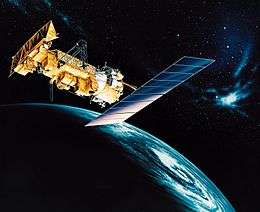NOAA-15
NOAA-15 (designated NOAA-K before launch) is one of the NASA-provided TIROS series of weather forecasting satellite run by NOAA. It was launched on May 13, 1998, and is currently semi-operational, in a sun-synchronous orbit, 807 km above the Earth, orbiting every 101 minutes. It hosts the AMSU-A and AMSU-B instruments, the AVHRR and High Resolution Infrared Radiation Sounder (HIRS/3) instruments, as well as a Space Environment Monitor (SEM/2).[6] It also hosts Cospas-Sarsat payloads.
 Artist's impression of NOAA-15 in orbit | |
| Mission type | Weather satellite |
|---|---|
| Operator | NOAA |
| COSPAR ID | 1998-030A |
| SATCAT no. | 25338 |
| Mission duration | 2 years[1] |
| Spacecraft properties | |
| Spacecraft type | TIROS-N |
| Manufacturer | Lockheed Martin |
| Launch mass | 1,457 kilograms (3,212 lb)[2] |
| Power | 830 watts[3] |
| Start of mission | |
| Launch date | May 13, 1998, 15:52:04 UTC[4] |
| Rocket | Titan II(23)G Star-37XFP-ISS |
| Launch site | Vandenberg SLC-4W |
| Orbital parameters | |
| Reference system | Geocentric |
| Regime | Sun-synchronous |
| Semi-major axis | 7,184.62 kilometers (4,464.32 mi)[5] |
| Eccentricity | 0.001007[5] |
| Perigee altitude | 804.6 kilometers (500.0 mi)[5] |
| Apogee altitude | 821.0 kilometers (510.1 mi)[5] |
| Inclination | 98.80 degrees[5] |
| Period | 101.01 minutes[5] |
| Epoch | January 24, 2015, 13:51:02 UTC[5] |
Advanced TIROS-N | |
APT transmission frequency is 137.62 MHz. Due to problems with the S-band transmitter high-gain antennas, NOAA-15 has been configured for High Resolution Picture Transmission using the S-Band Transmitter #2 (1702.5 MHz) omnidirectional antenna.[7]
Failure of the AVHRR scanning motor
On July 22, 2019 NOAA-15 began transmitting corrupt data.[8] The cause appears to be instability of the scanning motor for the AVHRR sensor[9]. According to an official release from NOAA, on July 23rd at 0400 Zulu time, the current draw of that motor spiked, as did the motor temperature. Additionally, the sensor stopped producing data. NOAA says this is consistent with a motor stall, and could be permanent.[10] On July 25th 2019, the AVHRR motor spontaneously recovered. The cause of the failure is still under investigation.
On July 30th, 2019 the AVHRR motor suffered another failure consistent with motor stall.[11] As per the previous statement by NOAA, recovery is unlikely.
Official Statement from NOAA
As of ~0000 UTC July 30, 2019 (DOY 211), the AVHRR motor current has once again started spiking, becoming saturated above 302mA at ~0600 UTC. The instrument is once again no longer producing data and may be stalled. The current plan is to leave the instrument powered as this issue may be intermittent.
External Links
References
- Krebs, Gunter. "NOAA 15, 16, 17 (NOAA K, L, M)". Gunter's Space Page. Retrieved December 8, 2013.
- "NOAA 15". National Space Science Data Center. Retrieved December 8, 2013.
- "UCS Satellite Database". Union of Concerned Scientists. Retrieved December 8, 2013.
- McDowell, Jonathan. "Launch Log". Jonathan's Space Page. Retrieved December 8, 2013.
- "NOAA 15 Satellite details 1998-030A NORAD 25338". N2YO. January 24, 2015. Retrieved January 25, 2015.
- "NOAA-N Prime" (PDF). NP-2008-10-056-GSFC. NASA Goddard Space Flight Center. December 16, 2008. Archived from the original (PDF) on February 16, 2013. Retrieved October 8, 2010.
- NOAA 15 Spacecraft Status Summary Archived May 27, 2010, at the Wayback Machine
- "SR1GEO GS Satellite Observation 13711".
- "NOAA-15 AVHRR Scan Motor Current Increase Event".
- "NOAA-15 AVHRR Scan Motor Current Increase Event".
- "NOAA 15 satellite observation". SR1GEO Satellite Images. Retrieved July 30, 2019.